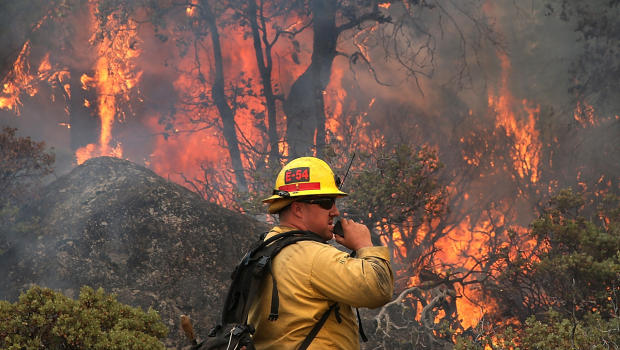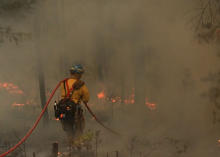Yosemite fire swallowing everything in its path
Updated at 10 p.m. ET
GROVELAND, Calif. The fastest-growing wildfire in the nation is now raging in parts of Yosemite National Park, CBS News correspondent Teresa Garcia reports.
At nearly 200 square miles, the massive fire is swallowing everything in its path, threatening more than 4,500 homes, buildings and campsites and burning more than 125,000 acres.
On Saturday night, officials in San Francisco were monitoring the situation closely.
The fire is threatening some of San Francisco's vital utilities. The city owns power lines just outside the fire zone, and 85 percent of its water comes from the Hetch Hetchy reservoir, which is about 4 miles from the inferno.
The flames have already shut down two of the city's hydroelectric power plants. Gov. Jerry Brown has declared a state of emergency.
More than 2,600 firefighters and a half dozen aircraft are battling the blaze.
The city is fearing ash contamination to the water supply, so on Friday it announced it's prepared to tap backup reservoirs.
"The biggest message is the water is safe," said Michael Carlin of the Public Utilities Commission. "We have emergency procedures for it. We know what to do, and we feel very confident that we can provide the water to each and every one of our customers."
The so-called "Rim Fire" is burning in several different directions and proving hard to contain. Fire officials say the thick smoke, dry brush and steep rugged terrain have made it difficult to carve out control lines.

U.S. Forest Service firefighter Chris Brossard talks on his radio while monitoring a spot fire while battling the Rim Fire Aug. 24, 2013, in Yosemite National Park, Calif.
/ Getty ImagesAs the fire rages along the remote northwest edge of Yosemite, officials cleared brush and set sprinklers to protect two groves of giant sequoias.
The iconic trees can resist fire, but dry conditions and heavy brush are forcing park officials to take extra precautions in the Tuolumne and Merced groves. About three dozen of the giant trees are affected.
"All of the plants and trees in Yosemite are important, but the giant sequoias are incredibly important both for what they are and as symbols of the National Park System," said spokesman Scott Gediman.
The trees grow naturally only on the western slopes of the Sierra Nevada and are among the largest and oldest living things on earth.

Wildfire racing through land near Yosemite
The Tuolumne and Merced groves in are in the north end of the park near Crane Flat. While the Rim Fire is still some distance away, park employees and trail crews are not taking any chances.
"We're not looking at them as any kind of immediate threat, but we're taking precautions," Gediman said.
More than 5,500 homes are threatened and four were destroyed. Voluntary and mandatory evacuations have been ordered.
The fire has been burning for a week. The cause is under investigation.
The fire held steady overnight at nearly 200 square miles along the park's northern border, but a spokesman for the California Department of Forestry and Fire Protection says firefighters didn't get their usual reprieve from cooler early morning temperatures Saturday.
"This morning we are starting to see fire activity pick up earlier than it has the last several days," said Cal Fire spokesman Daniel Berlant. "Typically, it doesn't really heat up until early afternoon. We could continue to see this fire burn very rapidly today."
The Rim Fire started in a remote canyon of the Stanislaus National Forest a week ago and is just 5 percent contained.
The fire has grown so large and is burning dry timber and brush with such ferocity that it has created its own weather pattern, making it difficult to predict in which direction it will move.
"As the smoke column builds up it breaks down and collapses inside of itself, sending downdrafts and gusts that can go in any direction," Berlant said. "There's a lot of potential for this one to continue to grow."
The tourist mecca of Yosemite Valley, the part of the park known around the world for such sights as the Half Dome and El Capitan rock formations and waterfalls, remained open, clear of smoke and free from other signs of the fire that remained about 20 miles away.
A four-mile stretch of State Route 120, one of three entrances into Yosemite on the west side remains closed. Two other western routes and an eastern route were open.
http://www.cbsnews.com/8301-201_162-57599975/yosemite-fire-swallowing-everything-in-its-path/
